聖敘爾比斯教堂(法語:Saint-Sulpice)是坐落於巴黎第六區的一座天主教教堂。
| Church of Saint-Sulpice | |
|---|---|
French: Église Saint-Sulpice | |
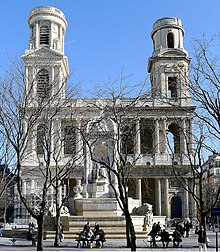 | |
| 48°51′04″N 2°20′05″E |
During the Directory, Saint-Sulpice was used as a Temple of Victory.[14] Redecorations to the interior, to repair extensive damage still remaining from the Revolution, were begun after the Concordat of 1801.[20] Eugène Delacroix added murals (1855–1861) that adorn the walls of the Chapel of the Holy Angels (first side-chapel on the right). The most famous of these are Jacob Wrestling with the Angel and Heliodorus Driven from the Temple.[21] A third, on the ceiling, is Saint Michael Vanquishing the Demon.
在目錄*中,聖敘爾皮斯被用作勝利之廟。[14] 1801年《協和號》生效後,開始進行內部裝修,以修復革命仍然留下的廣泛破壞。[20] 歐仁·德拉克洛瓦(EugèneDelacroix)添加了壁畫(1855-1861),裝飾壁畫的是聖天使教堂(右側的第一座小教堂)。 其中最著名的是雅各布與天使搏鬥和從聖殿趕來的赫利奧杜魯斯。[21] 第三個是天花板上的聖邁克爾·征服惡魔。
*Directory (political), a system under which a country is ruled by a college of several people who jointly exercise the powers of a head of state or head of government
- French Directory, the government in revolutionary France from 1795 to 1799
concordat :政教協定;政教條約:教廷與各國政府所訂有關宗教事務之條約。
Le combat avec l'Ange[modifier | modifier le code]
- Combat avec l'Ange
Delacroix reçoit la commande de trois fresques pour la chapelle des Anges l’église Saint-Sulpice de Paris en 1849, travail qu'il conduira jusqu'en 1861. Ces fresques Le Combat de Jacob et l'Ange et Héliodore chassé du temple accompagné de la lanterne du plafond Saint Michel terrassant le Dragon sont le testament spirituel du peintre. Pour les réaliser le peintre s'installe rue Furstenberg à deux pas. Il met au point un procédé à base de cire et de peinture l'huile pour peindre ses fresques dans une église à l'humidité endémique qui provoque la destruction des fresques par le salpêtre. Malade, il est épuisé par le travail dans le froid et les conditions difficiles. À l'inauguration des fresques, aucun officiel ne sera présent.
La fresque de la lutte de l'ange et de Jacob, illustre le combat entre le patriarche de la Bible et l'ange au centre gauche de la fresque au pied de trois arbres, et comporte de nombreuses allusions à son voyage au Maroc de 1832, à droite des personnages enturbannées sont cités avec des moutons et un chameau. À droite en bas des objets marocains et sur l'herbe au pied de Jacob, le sabre Marocain Nimcha156 qu'il avait rapporté de son voyage.
Terminé en 1860, la fresque de l'Héliodore chassé du temple, prend pour motif le moment où le général Séleucide, venu voler le trésor du Temple en est chassé par des anges cavaliers suivant le récit biblique du second Livre des Maccabées (3, 24-27). Delacroix associe dans une même vision le monde de l'Orient au monde biblique. Il puise son inspiration aussi dans l'histoire de la peinture dans la version de 1725 de Francesco Solimena du Louvre ou de celle de Raphaël.
Le plafond présente le combat victorieux de saint Michel contre le dragon, trois combats qui font écho à celui de Delacroix avec la peinture : « La peinture me harcèle et me tourmente de mille manières à la vérité, comme la maîtresse la plus exigeante ; depuis quatre mois, je fuis dès le petit jour et je cours à ce travail enchanteur, comme aux pieds de la maîtresse la plus chérie ; ce qui me paraissait de loin facile à surmonter me présente d’horribles et incessantes difficultés. Mais d’où vient que ce combat éternel, au lieu de m’abattre, me relève, au lieu de me décourager, me console et remplit mes moments, quand je l’ai quitté157 ? »
En 1861, Baudelaire publie un article élogieux sur les peintures de Saint-Sulpice, auquel Delacroix répond par une lettre chaleureuse au poète158. Baudelaire publie en 1863 l'œuvre et la vie d'Eugène Delacroix où il rend hommage au génie du peintre159.
Delacroix receives the order for three frescoes for the Chapel of the Angels the Saint-Sulpice church in Paris in 1849, a work that he will carry out until 1861. These frescoes The Combat of Jacob and the Angel and Heliodorus driven from the temple accompanied by the ceiling lantern of Saint Michael slaying the Dragon are the painter's spiritual testament. To achieve them, the painter moved to rue Furstenberg a stone's throw away. He developed a process based on wax and oil paint to paint his frescoes in a church with endemic humidity which caused the destruction of the frescoes by saltpetre. Sick, he was exhausted from working in the cold and in difficult conditions. At the inauguration of the frescoes, no official will be present.
The fresco of the fight of the angel and Jacob, illustrates the fight between the patriarch of the Bible and the angel in the center left of the fresco at the foot of three trees, and contains many allusions to his trip to Morocco in 1832 , on the right, turbaned figures are mentioned with sheep and a camel. To the right, below the Moroccan objects and on the grass at Jacob's foot, the Moroccan Nimcha156 saber that he had brought back from his trip.
Completed in 1860, the fresco of Heliodorus expelled from the temple, takes as its motive the moment when General Seleucides, who came to steal the temple's treasure, was driven out by cavalry angels according to the biblical account of the Second Book of the Maccabees (3, 24 -27). Delacroix associates in the same vision the world of the East with the biblical world. He also draws his inspiration from the history of painting in the 1725 version of Francesco Solimena from the Louvre or that of Raphaël.
| 3赫略多洛就來執行他所決定的事。 |
| 24當他與衛兵走近寶庫的時候,眾神和全能的主忽然大顯異像,使那些擅入聖殿的人,受到天主威能的打擊,驚惶失措,不省人事, |
| 25因為在他們眼前出現了一匹配備華麗的駿馬,上面騎著一位威嚴可怕的騎士,疾馳衝來,前蹄亂踏赫略多洛,騎馬的人身穿金黃的鎧甲。 |
| 26同時又出現了兩位英勇的少年,光榮體面,穿戴華麗,立在赫略多洛的兩旁,鞭打不停,使他身受重傷。 |
| 27赫略多洛忽然倒在地上,昏迷不省。人將他扶起,放在床上, |
| 28這即是方才帶著大批侍從和衛士來到寶庫的人,現在卻無能為力,為人抬出,公然承認了這是天主的大能。 |
| 29正當這人受天主大能的打擊,啞口失聲,絕望無救的時候, |
| 30猶太人卻同聲讚頌上主,因為上主光榮了自己的聖所;方才還充滿著恐怖驚慌的聖殿,如今卻因全能上主的顯現,充滿了歡喜快樂。 |
The ceiling presents the victorious fight of Saint Michael against the dragon, three fights which echo that of Delacroix with painting: “Painting harasses me and torments me in a thousand ways indeed, like the most demanding mistress; for four months, I have been fleeing at dawn and I run to this enchanting work, as at the feet of the most beloved mistress; what seemed from a distance easy to overcome presents me with horrible and incessant difficulties. But where does this eternal struggle come from, instead of bringing me down, picking me up, instead of discouraging me, consoling me and filling my moments, when I left it157? "
In 1861, Baudelaire published a laudatory article on the paintings of Saint-Sulpice, to which Delacroix replied with a warm letter to the poet158. Baudelaire published in 1863 the work and life of Eugène Delacroix in which he paid homage to the genius of the painter159.
***https://en.wikipedia.org/wiki/Jacob_wrestling_with_the_angel
| 25雅各伯獨自一人留在後面。有一人前來與他搏鬥一直到曙光破曉。 |
| 26那人見自己不能制勝,就在他的大腿窩上打了一下;雅各伯正在與他搏鬥之際,大腿窩脫了節。 |
| 27那人說:「讓我走罷!天已破曉。」雅各伯說:「你如果不祝福我,我不讓你走。」 |
| 28那人問他說:「你叫什麼名字?」他答說:「雅各伯。」 |
| 29那人說:「你的名字以後不再叫雅各伯,應叫以色列,因為你與神與人搏鬥,佔了優勢。」 |
| 30雅各伯問說:「請你告訴我你的名字。」那人答說:「為什麼你要問我的名字?」遂在那裏祝福了他。 |
| 31雅各伯給那地方起名叫「培尼耳」,意謂「我面對面見了神,我的生命仍得保全」。 |
| 32雅各伯經過培尼耳時,太陽已升起照在身上,由於大腿脫了節,他一走一瘸。 |
| 33為此,以色列子民至今不吃大腿窩上的筋,因為那人打了雅各伯的大腿窩,正打在筋上。 |
Jacob wrestling with the angel is described in Genesis (32:22–32; also referenced in Hosea 12:4). The "angel" in question is referred to as "man" (אִישׁ) and "God" in Genesis, while Hosea references an "angel" (מַלְאָךְ).[1] The account includes the renaming of Jacob as Israel (etymologized as "contends-with-God").
In the Genesis narrative, Jacob spent the night alone on a riverside during his journey back to Canaan. He encounters a "man" who proceeds to wrestle with him until daybreak. In the end, Jacob is given the name "Israel" and blessed, while the "man" refuses to give his own name. Jacob then names the place where they wrestled Penuel (פְּנוּאֵל "face of God" or "facing God"[2]).
Jacob Wrestles With God
22 That night Jacob got up and took his two wives, his two female servants and his eleven sons and crossed the ford of the Jabbok. 23 After he had sent them across the stream, he sent over all his possessions. 24 So Jacob was left alone, and a man wrestled with him till daybreak. 25 When the man saw that he could not overpower him, he touched the socket of Jacob’s hip so that his hip was wrenched as he wrestled with the man. 26 Then the man said, “Let me go, for it is daybreak.”
But Jacob replied, “I will not let you go unless you bless me.”
27 The man asked him, “What is your name?”
“Jacob,” he answered.
28 Then the man said, “Your name will no longer be Jacob, but Israel,[a] because you have struggled with God and with humans and have overcome.”
29 Jacob said, “Please tell me your name.”
But he replied, “Why do you ask my name?” Then he blessed him there.
30 So Jacob called the place Peniel,[b] saying, “It is because I saw God face to face, and yet my life was spared.”
31 The sun rose above him as he passed Peniel,[c] and he was limping because of his hip.
Footnotes
- Genesis 32:28 Israel probably means he struggles with God.
- Genesis 32:30 Peniel means face of God.
- Genesis 32:31 Hebrew Penuel, a variant of Peniel






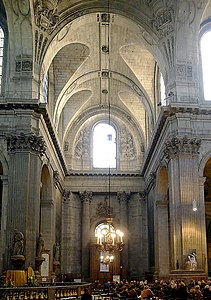

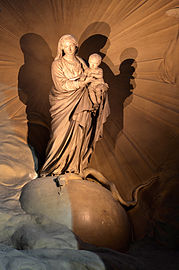


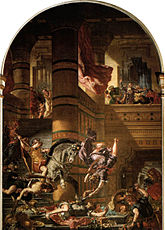

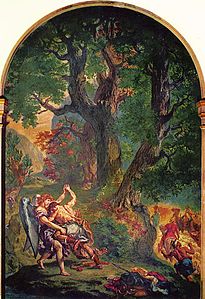


沒有留言:
張貼留言